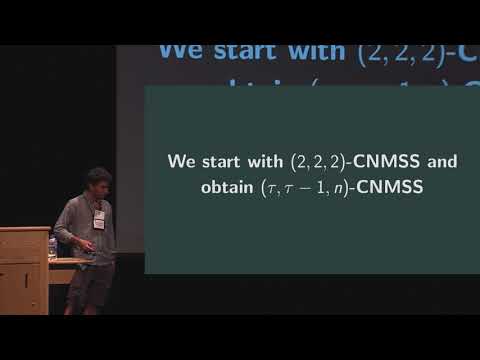CryptoDB
Non-malleable Secret Sharing in the Computational Setting: Adaptive Tampering, Noisy-Leakage Resilience, and Improved Rate
| Authors: | |
|---|---|
| Download: |
|
| Abstract: | We revisit the concept of non-malleable secret sharing (Goyal and Kumar, STOC 2018) in the computational setting. In particular, under the assumption of one-to-one one-way functions, we exhibit a computationally private, threshold secret sharing scheme satisfying all of the following properties. Continuous non-malleability: No computationally-bounded adversary tampering independently with all the shares can produce mauled shares that reconstruct to a value related to the original secret. This holds even in case the adversary can tamper continuously, for an unbounded polynomial number of times, with the same target secret sharing, where the next sequence of tampering functions, as well as the subset of shares used for reconstruction, can be chosen adaptively based on the outcome of previous reconstructions.Resilience to noisy leakage: Non-malleability holds even if the adversary can additionally leak information independently from all the shares. There is no bound on the length of leaked information, as long as the overall leakage does not decrease the min-entropy of each share by too much.Improved rate: The information rate of our final scheme, defined as the ratio between the size of the message and the maximal size of a share, asymptotically approaches 1 when the message length goes to infinity. Previous constructions achieved information-theoretic security, sometimes even for arbitrary access structures, at the price of at least one of the following limitations: (i) Non-malleability only holds against one-time tampering attacks; (ii) Non-malleability holds against a bounded number of tampering attacks, but both the choice of the tampering functions and of the sets used for reconstruction is non-adaptive; (iii) Information rate asymptotically approaching zero; (iv) No security guarantee in the presence of leakage. |
Video from CRYPTO 2019
BibTeX
@article{crypto-2019-29895,
title={Non-malleable Secret Sharing in the Computational Setting: Adaptive Tampering, Noisy-Leakage Resilience, and Improved Rate},
booktitle={Advances in Cryptology – CRYPTO 2019},
series={Lecture Notes in Computer Science},
publisher={Springer},
volume={11693},
pages={448-479},
doi={10.1007/978-3-030-26951-7_16},
author={Antonio Faonio and Daniele Venturi},
year=2019
}

